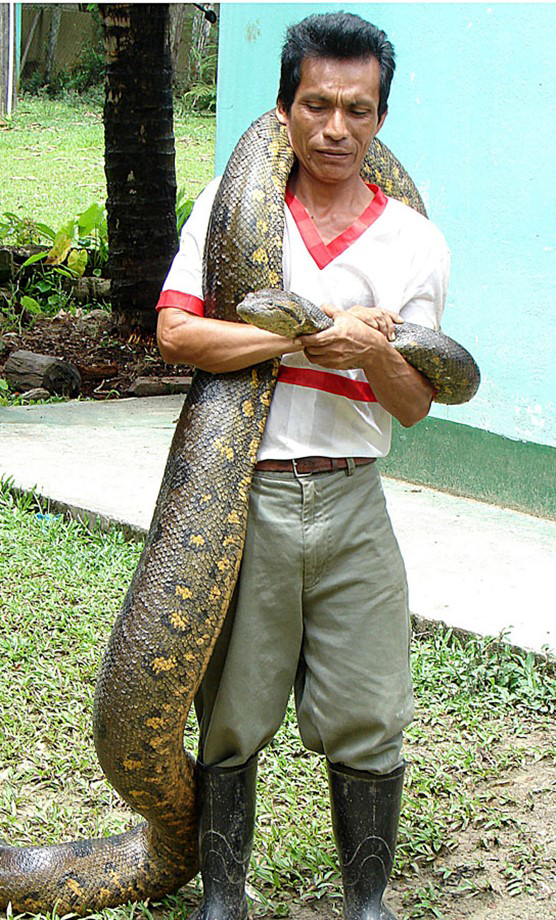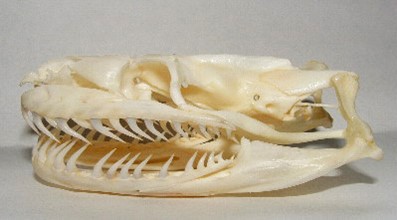
Credit: Mokele, CC BY-SA 3.0, via Wikimedia Commons
How ‘bout a boa burger? Or snake steak?
As the world’s population looks for more sources of protein, snakes in the constrictor family may be the perfect choice.
That’s because, over millions of years, they’ve evolved to grow and maintain a healthy body weight while eating little.
Recently, researchers studied Burmese and reticulated pythons bred for consumption in snake farms in Vietnam and Thailand.
On a diet of wild rodents, pork by-products and fish pellets, they added about half a pound of body weight a week, converting feed into edible protein more efficiently than cows, pigs, chicken, salmon or even crickets, as we discussed on another EarthDate.
They produced less feces and greenhouse gases than those protein sources, too. They drank the dew that formed on their scales and didn’t need additional water. They thrived in heat and maintained their weight during fasting. And they didn’t transmit diseases like bird flu.
The scientists concluded that, if it could be scaled up, python “ranching” could provide a sustainable protein source that supports local farmers while preserving wild snake populations and habitats.
Snake meat is already popular in Asian countries and is available in some gourmet food stores here, too. It “tastes a lot like chicken” and can be prepared using similar recipes.
So, you might consider making some python piccata or anaconda adobo to give this protein of the future a try.
Background
Synopsis: As the world’s population grows, the need for sustainable protein sources grows, too. It turns out that snake meat may be one of the most sustainable protein sources on the planet. How about a boa burger or python piccata for dinner?
- In the search for protein to feed humanity in the future, scientists are looking at unconventional sources.
- We talked about future use of farmed insect protein in a previous EarthDate episode (ED-305 Grub’s Up).
- It turns out that snake meat may be an even more Earth friendly protein source.
- The largest living snakes on Earth, by both weight and length, are nonvenomous constrictors, including pythonids (pythons) and their cousins the boids (anacondas and boa constrictors).
- The reticulated python, from the Pythonidae family, is the longest snake currently living on Earth, with certified measurements of up to 22.8 ft (6.95 m) and unsubstantiated reports of lengths up to 33 ft (10 m).

Large reticulated pythons are occasionally found on the outskirts of Bangkok, Thailand. Usually, a minimum of two wildlife rescue experts are required to successfully extract snakes as large as this one, measured at 13 feet (4 meters).
Credit: vvar, CC BY-SA 4.0, via Wikimedia Commons
A zookeeper handles a docile anaconda at the ophiological center in Leticia, Colombia. Ophiology is the study of snakes.
Credit: Dick Culbert, CC BY 2.0, via Wikimedia Commons - The chubbier green anaconda is from the Boidae family. It is about twice as thick as a python and holds the record as the world’s heaviest snake, weighing in at as much as 500 lbs (227 kg) and reportedly reaching 27.7 ft in length (8.43 m) as spotted in the wild, although the longest anaconda ever officially measured was “only” 17.1 ft long (5.21 m).

A size comparison of four different snakes comparing large individuals of the present-day green anaconda (Eunectes murinus) and reticulated python (Malayopython reticulatus) to total length estimates of the extinct Gigantophis (37–35 Ma) and Titanoboa (60–58 Ma). Recent discovery of an Eocene species in the Madtsoiidae family, Vasuki indicus, is thought to have been even larger, at 50 ft (15 m) long, and lived about 40 million years ago.
Credit: Gamma 124, CC BY-SA 4.0, via Wikimedia Commons
- The reticulated python, from the Pythonidae family, is the longest snake currently living on Earth, with certified measurements of up to 22.8 ft (6.95 m) and unsubstantiated reports of lengths up to 33 ft (10 m).
- But they were even bigger in the past. A now-extinct family of constrictor-type snakes, Madtsoiidae, began slithering around the Cretaceous globe about 98 million years ago.
- Then, the first boids evolved in the latest Cretaceous Period, about 70 million years ago, while the oldest pythonid fossils, found in the Eocene Epoch of Germany, are 48 million years old.
- A fossil constrictor from India has just slinked past South America’s Titanoboa for the title of Earth’s largest-ever fossil snake.
- Found in fossilized lagoon deposits in western India (the region between the southern border of Pakistan and the Indian city of Mumbai), Vasuki indicus was estimated to have been 50 ft (15 m) long.
- It lived in the Eocene Epoch about 40 million years ago, but its entire family (Madtsoiidae) is now extinct. It was named for the serpent god, Vasuki, from Hindu mythology.

The snake Nag Vasuki being used as a rope by the supernatural Devas and Asuras during the Samudra Manthan, the churning of the ocean to produce the elixir of eternal life, from Hindu legends.
Credit: Anonymous, public domain, via Wikimedia Commons
- The previous record holder, Titanoboa, was found in brackish lake deposits in a coal mine in northernmost Colombia, and had an estimated length of around 42 ft (12.8 m).
- This genus of snakes lived during the Paleocene Epoch 60 to 58 million years ago.
- It is now extinct, but it was a genus in the Boidae family, like today’s anacondas and boa constrictors.
- Before that, another member of the Madtsoiidae family, Gigantophis, was thought to have been the longest snake ever at 31 to 35 ft (9.3–10.7 m).
- It lived during the Eocene Epoch 37 to 35 million years ago.
- In Asia, snake meat is a delicacy and is used in traditional medicines. Snake skins are also in high demand.
- Recently, researchers spent a year studying more than 4,600 specimens of both Burmese (Python bivittatus) and reticulated pythons (Malayopython reticulatus) at existing farms in Vietnam and Thailand.
- These snakes are hatched from eggs laid at the farm and housed in enclosures within large, open-air warehouse barns as they grow.
- In the first year of life, the amount of feed required to produce a pound of meat (known as the feed conversion ratio) was less for pythons than for other sources of protein including beef, pork, chicken, salmon and even crickets.
- Females grew faster than males, adding up to 1.6 oz (45 g) per day on a diet of wild rodents, pork by-products and fish pellets.
- Researchers concluded that, if it can be scaled up, python “ranching” will provide a sustainable solution for protein production.
- Pythons get their water by drinking the dew that forms on their scales each morning, and they don’t need additional water.
- They excrete less feces and produce fewer greenhouse gases than other protein sources.
- These heat-tolerant animals were never force-fed and maintained their weight when fasting.
- With their very slow metabolic rate, they are able to survive without food for as much as a year.
- Pythons don’t transmit human-threatening airborne diseases like bird flu (although their bites can cause nasty bacterial infections, and all captive snakes carry Salmonella bacteria).
- Novel sources of protein are particularly important in regions around the globe where current or likely future food insecurity is an issue.
- Local communities might nurture their local snake populations and habitats because of financial incentives to partner with farms to raise baby snakes for the farms, making them a small business cash crop.
- Similar to insect protein, Western taste for snake protein may not catch on quickly because people are generally afraid of snakes.
- Pythons can live for up to 20 years in the wild and are native in Africa, Asia and Australia. After being imported and released, Burmese pythons are invasive in the Florida Everglades.
- While slow moving and nonvenomous, pythons can consume small pets.
- Pythons are characterized by their muscular bodies and backward-facing teeth that pull whole prey deeper and deeper into their incredibly flexible jaws.

A Burmese python skull with its backward-facing teeth.
Credit: Mokele, CC BY-SA 3.0, via Wikimedia Commons - Depending on their size, pythons may eat insects, birds and mammals (monkeys, pigs and deer), stalking their prey slowly then striking rapidly.
- As constrictors, they use their physical strength to squeeze and cut off blood flow to kill their prey.
- Snake tastes similar to chicken but is a little more gamey.
- Since snakes don’t have any appendages, they are easy to butcher and very little is wasted. Just one long slice of a knife yields a 13 ft long (4 m) white meat filet.
- Python can be substituted for chicken in many recipes, so if this episode has left you craving a snake filet, here is an easy recipe you can make at home:
- Dredge filets in flour until evenly coated.
- In a large pan that is safe to transfer into the oven, heat a thin layer of olive oil over medium heat, then add the python strips.
- Sear on both sides until golden brown, then transfer the whole pan to a 350°F (175°C) oven and bake to an internal temperature of 175°F (80°C).

Python filet is available from exotic meat stores like Tillman’s Meats in Jacksonville, Florida. It tastes a lot like chicken, so look for ground python in your grocer’s freezer in the next decade or so.
Credit: Tillman’s Meats
- It is also said to be tasty barbecued as satay skewers, curried and as jerky.
- In the future, you may be able to enjoy boa burger, python piccata or adobo anaconda for dinner, but take care to check their source.
- Wild Burmese pythons are an invasive species in the Florida Everglades and are actively hunted to cull the population, but meat from these animals may be contaminated with high levels of mercury, so look for farmed python.

